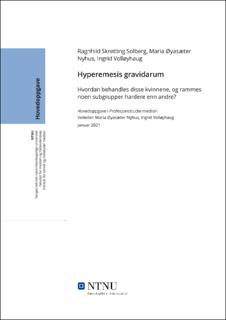| dc.contributor.advisor | Nyhus, Maria Øyasæter | |
| dc.contributor.advisor | Volløyhaug, Ingrid | |
| dc.contributor.author | Ragnhild Skretting Solberg | |
| dc.contributor.author | Maria Øyasæter Nyhus | |
| dc.contributor.author | Ingrid Volløyhaug, | |
| dc.date.accessioned | 2021-09-13T16:16:54Z | |
| dc.date.available | 2021-09-13T16:16:54Z | |
| dc.date.issued | 2021 | |
| dc.identifier | no.ntnu:inspera:71800818:9142886 | |
| dc.identifier.uri | https://hdl.handle.net/11250/2775981 | |
| dc.description.abstract | Bakgrunn
Uttalt svangerskapskvalme, Hyperemesis gravidarum (HG), gir betydelig morbiditet og nødvendiggjør sykehusinnleggelse med kvalmestillende, intravenøs væskebehandling og eventuelt enteral/parenteral ernæring. Hovedmål var å kartlegge om behandlingen av kvinner med hyperemesis gravidarum ved St. Olavs hospital samsvarer med avdelingens retningslinjer og hvordan disse samsvarer med Norsk Gynekologisk Forening (NGF) sin nasjonale veileder. Sekundært mål var å undersøke om alvorlighetsgrad av HG hadde innvirkning på valg av behandling og om førstegangsgraviditet, tidligere HG, etnisitet og BMI var assosiert med alvorlighetsgrad, behandling av HG og fødselsvekt.
Materiale og metode
Retrospektiv tverrsnittstudie med journaldata fra 108 kvinner behandlet for HG ved Kvinneklinikken (KK) ved St. Olavs hospital i 2018 og 2019. Pregnancy-Unique Quantification of Emesis and Nausea (PUQUE) ble brukt for å gradere alvorlighetsgrad av HG. Vi brukte Mann-Whitney U test og Chi kvadrat-test for sammenlikning av grupper.
Resultater
I motsetning til lokal veileder anbefalte Nasjonal veileder tilbakeholdenhet med antiemetika ved PUQE<13 og væskebehandling først ved PUQUE ≥13. Det ble tatt innkomstblodprøver av alle, mens blodtrykk, puls og vekt ble målt hos 80%. Alle sykehusinnlagte ble, i tråd med lokale og nasjonale retningslinjer, behandlet med antihistaminer som førstevalg. Kvinner med tidligere HG fikk mer Ondansetron (50% vs. 22%, p=0.009). En større andel av de etnisk skandinaviske hadde prøvd antiemetika før sykehus innleggelsen (57% vs. 33%, p= 0.021), og de prøvde flere ulike typer antiemetika under sykehusoppholdet. En større andel av de med under anbefalt vektøkning hadde prøvd antiemetika før sykehusinnleggelsen (68% vs. 39%, p= 0.037) og de fødte barn med grensesignifikant 195g lavere fødselsvekt (p=0,057). Verken paritet, tidligere HG, etnisitet eller BMI var assosiert med alvorlighetsgrad av HG (PUQE <13 og ≥13).
Konklusjon
Det var små forskjeller på lokale retningslinjer ved St. Olavs og NGFs retningslinjer av 2014, og de ble fulgt på de fleste punkter i 2018 og 2019. Tidligere HG, etnisitet og lav vektøkning i svangerskapet var assosiert med valg av antiemetika, men ikke alvorlighetsgrad av HG ved innleggelse. Lav vektøkning rammet halvparten av kvinnene, og tenderte mot å gi lavere fødselsvekt. | |
| dc.description.abstract | Background
Pronounced pregnancy nausea, Hyperemesis gravidarum (HG), causes significant morbidity and necessitates hospitalization with antiemetics, intravenous fluid therapy and possibly enteral/parenteral nutrition. The main goal was to map whether the treatment of women with hyperemesis gravidarum at St. Olav's hospital complies with the department's guidelines and how these comply with the Norwegian Gynecological Association's (NGF) national guide. The secondary objective was to investigate whether the severity of HG had an impact on the choice of treatment and whether first-time pregnancy, previous HG, ethnicity and BMI were associated with severity, treatment of HG and birth weight.
Material and method
Retrospective cross-sectional study with journal data from 108 women treated for HG at the Women's Clinic (KK) at St. Olav's hospital in 2018 and 2019. Pregnancy-Unique Quantification of Emesis and Nausea (PUQUE) was used to grade severity of HG. We used the Mann-Whitney U test and the Chi square test to compare groups.
Results
In contrast to the local guideline, the national guideline recommended restraint with antiemetics at PUQE <13 and fluid therapy first at PUQUE ≥13. Income blood samples were taken from everyone, while blood pressure, heart rate and weight were measured in 80%. All hospital admissions were, in accordance with local and national guidelines, treated with antihistamines as the first choice. Women with previous HG received more Ondansetron (50% vs. 22%, p = 0.009). A larger proportion of the ethnic Scandinavians had tried antiemetics before hospitalization (57% vs. 33%, p = 0.021), and they tried several different types of antiemetics during their hospital stay. A larger proportion of those with below recommended weight gain had tried antiemetics before hospitalization (68% vs. 39%, p = 0.037) and gave birth to infants with borderline significant 195g lower birth weight (p = 0.057). Neither parity, previous HG, ethnicity nor BMI were associated with severity of HG (PUQE <13 and ≥13).
Conclusion
There were small differences in local guidelines at St. Olav's and NGF's guidelines of 2014, and they were followed at most points in 2018 and 2019. Previous HG, ethnicity and low weight gain in pregnancy were associated with choice of antiemetics, but not severity of HG at admission. Low weight gain affected half of the women and tended to result in lower birth weight. | |
| dc.language | nob | |
| dc.publisher | NTNU | |
| dc.title | Hyperemesis gravidarum – Hvordan behandles disse kvinnene, og rammes noen subgrupper hardere enn andre? | |
| dc.type | Master thesis | |
